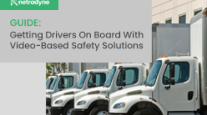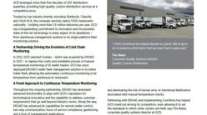Class 8 Fleet Grows 0.9% in 3Q, Biggest Gain in 3 Years, Polk Says
This story appears in the Dec. 3 print edition of Transport Topics.
The total number of U.S. heavy-duty vehicles in operation rose 0.9% during the third quarter, the highest level of growth since the third quarter in 2009, according to a report from R.L. Polk & Co.
Total fleet size had contracted nine of the previous 11 quarters, and this latest report could mark an end to that trend, said Gary Meteer, the author of the report.
“I think we’ll be seeing a slow increase in Class 8 vehicles in operation now, but Class 8 ultimately grows as the economy does. We’re seeing a replacement market for new truck registrations and companies following up with their business models, but I don’t see robust increases coming,” Meteer said.
Polk also reported that used truck transactions still outnumber registrations for new Class 8s, but the used-vehicle deals are declining from high levels, while the new vehicles continue to grow at a slow pace. Also, the registration of new trailers — 24 feet long and up — continue to rise at about the same pace as new heavy-duty trucks, Polk said.
While the report looks at all heavy-duty vehicles — including dump trucks, cement mixers and refuse vehicles — Bob Costello, American Trucking Associations’ chief economist, tracks Class 8 tractors that haul freight, and said his results are similar.
Looking at truckload carriers on Sept. 30, Costello said aggregate fleet size for large truckload carriers has risen 1.2% compared with the first nine months of 2011. For small truckload carriers — with less than $30 million in annual revenue — the tractor count is up 0.6%.
Costello said he thinks more trucking companies would like to buy additional trucks, but at roughly $125,000 for a new Class 8 highway tractor, price becomes a daunting obstacle.
“It’s a struggle for a lot of fleets,” Costello said. “It has the potential to drive carriers out of business.”
Owner-operators emphasize the importance of the issue, said Norita Taylor, a spokeswoman for the Owner-Operator Independent Drivers Association.
“We agree that there is a certain amount of new truck sales growth, possibly due to new Environmental Protection Agency standards, but more so we see a strong demand for used equipment,” she said. “The problem is that the single owner-operator cannot afford new truck purchases and so the used truck market is getting bought up. Even with the best possible loan terms, a monthly payment on a new truck is around $2,400 and they can’t justify that expense.”
Polk figures show the nation’s Class 8 fleet peaking at 3.65 million vehicles at the end of 2008, and that it has fallen to 3.52 million big trucks on Sept. 30.
As for the characteristics associated with those trucks, Polk said many of the nation’s pre-2000 trucks have been scrapped or exported and replaced with new trucks, the sale and registration of which have grown since the worst of sales in 2009.
In fact, buying a less-old used truck to replace an older truck is still the most popular type of transaction.
Going back to the start of 2006, the best quarter for U.S. used truck transactions was April to June of 2010, when 107,000 Class 8s changed hands. By Sept. 30 of this year, the level fell to 60,500 for the quarter. In contrast, new truck registrations hit bottom in the second quarter of 2009 at 24,500 for the quarter, and rose to 48,958 heavy trucks in the most recent quarter.
Polk’s Meteer agreed with OOIDA’s Taylor that more used trucks would be sold if the supply were greater.
“During the fourth quarter of 2011 we started seeing the dearth of used trucks. Good, clean used equipment is now selling at a premium and is hard to find,” Meteer said.
Private fleets are natural customers for new trucks, said Gary Strausbaugh, chairman of the National Private Truck Council. Strausbaugh said many of the council’s members are buying, but they are also working to lessen their need for new vehicles.
“At our meeting in September, most of the people I spoke to were adding trucks. Maybe not a whole lot, but they were adding,” said Strausbaugh, who is also the vice president of transportation for Mennel Milling Co. in Fostoria, Ohio.
Strausbaugh said private fleets often have to customize vehicles for very specific applications, so making that extra investment for a used truck is usually not worth it. Private fleets, however, are also increasing their use of route-optimization software, “so we can move more freight with less equipment,” Strausbaugh said.
In looking at new trailer purchases, Polk found that 162,277 of them have been registered in the first nine months of the year, an 11.4% gain over the first three quarters of 2011. Trailer registrations have also been growing since 2009, but this year’s growth is less rapid than the 2011 pace.




